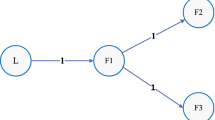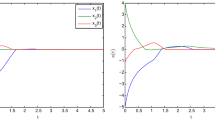Abstract
In order to synchronize a network of Euler–Lagrangian (EL) systems, a distributed output-feedback control is proposed in this paper. The adopted mathematical model of EL systems possesses nonlinear uncertainties, unmeasured states, and stochastic disturbances. By introducing prescribed performance control (PPC) in a dynamic surface control approach, a novel distributed neural adaptive PPC design is presented. Simultaneously, one outstanding characteristic is that the minimal learning parameter approach is employed in the dynamic surface control methodology. It is proved that the norm of distributed tracking errors is confined to compact set with predefined convergence rates and maximum overshoots by using stochastic Lyapunov analysis and graph theory. Finally, simulation examples validate the effectiveness of the proposed approach.






Similar content being viewed by others
References
Ren, W.: On consensus algorithms for double-integrator dynamics. IEEE Trans. Autom. Control 53(6), 1503–1509 (2008)
Olfati-Saber, R., Fax, J.F., Murray, R.M.: Consensus and cooperation in networked multi-agent systems. Proc. IEEE 95(1), 215–233 (2007)
Olfati-Saber, R.: Flocking for multi-agent dynamic systems: algorithms and theory. IEEE Trans. Autom. Control 51(3), 401–420 (2006)
Ren, W., Beard, R.: Formation feedback control for multiple spacecraft via virtual structures. IEE Proc. Control Theory Appl. 151(3), 357–368 (2004)
Olfati-Saber, R., Murray, R.M.: Consensus problems in networks of agents with switching topology and time-delays. IEEE Trans. Autom. Control 49(9), 1520–1533 (2004)
Ren, R., Beard, R.W.: Consensus seeking in multiagent systems under dynamically changing interaction topologies. IEEE Trans. Autom. Control 50(5), 655–661 (2005)
Wang, X., Qin, J., Yu, C.: ISS method for coordination control of nonlinear dynamical agents under directed topology. IEEE Trans. Cybern. 44(10), 1832–1845 (2014)
Meng, Z., Ren, W., Cao, Y., You, Z.: Leaderless and leader-following consensus with communication and input delays under a directed network topology. IEEE Trans. Syst. Man Cybern. 41(1), 75–88 (2011)
Wang, Y., Song, Y., Lewis, F.L.: Robust adaptive fault-tolerant control of multi-agent systems with uncertain non-identical dynamics and undetectable actuation failures. IEEE Trans. Ind. Electron. 62(6), 3978–3988 (2015)
Yoo, S.J.: Synchronised tracking control for multiple strict-feedback nonlinear systems under switching network. IET Control Theory Appl. 8(8), 546–553 (2014)
Ding, Z.: Adaptive consensus output regulation of a class of nonlinear systems with unknown high-frequency gain. Automatica 51(1), 348–355 (2015)
Chen, W., Li, X., Ren, W., Wen, C.: Adaptive consensus of multi-agent systems with unknown identical control directions based on a novel Nussbaum-type function. IEEE Trans. Autom. Control 59(7), 1887–1892 (2014)
Cheng, L., Hou, Z.G., Tan, M., Lin, Y., Zhang, Z.: Neural-network-based adaptive leader following control for multi-agent systems with uncertainties. IEEE Trans. Neural Netw. 21(8), 1351–1358 (2010)
Ma, H., Wang, Z., Wang, D., Liu, D., Yan, P., Wei, Q.: Neural-network-based distributed adaptive robust control for a class of nonlinear multi-agent systems with time delays and external noises. IEEE Trans. Syst. Man Cybern. 46(6), 750–758 (2016)
Shen, Q., Shi, P.: Output consensus control of multiagent systems with unknown nonlinear dead zone. IEEE Trans. Syst. Man Cybern. 46(10), 1329–1337 (2016)
Chen, C.L.P., Wen, G.X., Liu, Y.J., Liu, Z.: Observer-based adaptive backstepping consensus tracking control for high-order nonlinear semi-strict-feedback multiagent systems. IEEE Trans. Cybern. 46(7), 1591–1691 (2016)
Yoo, S.J.: Distributed consensus tracking for multiple uncertain nonlinear strict-feedback systems under a directed graph. IEEE Trans. Neural Netw. Learn. Syst. 24(4), 666–672 (2013)
Yoo, S.J.: Distributed adaptive containment control of networked flexible-joint robots using neural networks. Expert Syst. Appl. 41(2), 470–477 (2014)
Shahvali, M., Shojaei, Kh: Distributed adaptive neural control of nonlinear multi-agent systems with unknown control directions. Nonlinear Dyn. 83(4), 2213–2228 (2016)
Wang, G., Wang, C., Li, L., Zhang, Z.: Designing distributed consensus protocols for second-order nonlinear multi-agents with unknown control directions under directed graphs. J. Frankl. Inst. 354(1), 571–592 (2017)
Wang, W., Wang, D., Peng, Z.H., Li, T.: Prescribed performance consensus of uncertain nonlinear strict-feedback systems with unknown control directions. IEEE Trans. Syst. Man Cybern. 46(9), 1279–1286 (2016)
Swaroop, D., Hedrick, J.K., Yip, P.P., Gerdes, J.C.: Dynamic surface control for a class of nonlinear systems. IEEE Trans. Autom. Control 45(10), 1893–1899 (2000)
Li, W., Zhang, J.F.: Distributed practical output tracking of high-order stochastic multi-agent systems with inherent nonlinear drift and diffusion terms. Automatica 50(12), 3231–3238 (2014)
Wang, F., Chen, B., Lin, C., Li, X.: Distributed adaptive neural control for stochastic nonlinear multiagent systems. IEEE Trans. Cybern. doi:10.1109/TCYB.2016.2623898
Mei, J., Ren, W., Li, B., Ma, G.: Distributed containment control for multiple unknown second-order nonlinear systems with application to networked Lagrangian systems. IEEE Trans. Neural Netw. Learn. Syst. 26(9), 1885–1895 (2015)
Chen, G., Lewis, F.L.: Distributed adaptive tracking control for synchronization of unknown networked Lagrangian systems. IEEE Trans. Syst. Man Cybern. 41(3), 805–816 (2011)
Nuno, E., Ortega, R., Basaez, L., Hill, D.: Synchronization of networks of nonidentical Euler–Lagrange systems with uncertain parameters and communication delays. IEEE Trans. Autom. Control 56(4), 935–941 (2011)
Mei, J., Ren, W., Ma, G.: Distributed coordinated tracking with a dynamic leader for multiple Euler–Lagrange systems. IEEE Trans. Autom. Control 56(6), 1415–1421 (2011)
Wang, W., Huang, J., Wen, C., Fan, H.: Distributed adaptive control for consensus tracking with application to formation control of nonholonomic mobile robots. Automatica 50(4), 1254–1263 (2014)
Liu, L., Wang, D., Peng, Z.H.: Direct and composite iterative neural control for cooperative dynamic positioning of marine surface vessels. Nonlinear Dyn. 81(3), 1315–1328 (2015)
Ghommama, J., Saad, M.: Backstepping-based cooperative and adaptive tracking control design for a group of underactuated AUVs in horizontal plan. Int. J. Control 87(5), 1076–1093 (2014)
Tang, Y., Gao, H., Kurths, J.: Distributed robust synchronization of dynamical networks with stochastic coupling. IEEE Trans. Circuits Syst. I Regul. Pap. 61(5), 1508–1519 (2014)
Ji, H.B., Xi, H.: Adaptive output feedback tracking for stochastic nonlinear systems. IEEE Trans. Autom. Control 51(2), 355–360 (2006)
Has’minskii, R.Z.: Stochastic Stability of Differential Equations. Springer, Berlin (1980)
Zhang, H., Lewis, F.L.: Adaptive cooperative tracking control of higher-order nonlinear systems with unknown dynamics. Automatica 48(7), 1432–1439 (2012)
Polycarpou, M.M.: Stable adaptive neural control scheme for nonlinear systems. IEEE Trans. Autom. Control 41(3), 447–451 (1996)
He, W., Ge, S.S., Li, Y., Chew, E., Ng, Y.S.: Neural network control of a rehabilitation robot by state and output feedback. J. Intell. Robot. Syst. 80(1), 15–31 (2014)
Tee, K.P., Ge, S.S.: Control of fully actuated ocean surface vessels using a class of feed forward approximator. IEEE Trans. Control Syst. Technol. 14(41), 750–756 (2006)
Do, K.D.: Control of fully actuated ocean vehicles under stochastic environmental loads in three dimensional space. Ocean Eng. 99, 34–43 (2015)
He, W., Dong, Y., Sun, C.: Adaptive neural impedance control of a robotic manipulator with input saturation. IEEE Trans. Syst. Man Cybern. 46(3), 334–344 (2016)
Zhao, Z., He, W., Ge, S.S.: Adaptive neural network control of a fully actuated marine surface vessel with multiple output constraints. IEEE Trans. Control Syst. Technol. 22(4), 1536–1543 (2014)
He, W., Chen, Y., Yin, Z.: Adaptive neural network control of an uncertain robot with full-state constraints. IEEE Trans. Cybern. 46(3), 620–629 (2016)
Tong, S.C., Sui, S., Li, Y.: Fuzzy adaptive output feedback control of MIMO nonlinear systems with partial tracking errors constrained. IEEE Trans. Fuzzy Syst. 23(4), 729–749 (2015)
Krstic, M., Kanellakopoulos, I., Kokotovic, P.: Nonlinear and Adaptive Control Design. Wiley, New York (1995)
Cui, R., Ren, B., Ge, S.S.: Synchronised tracking control of multi-agent system with high-order dynamics. IET Control Theory Appl. 6(5), 603–614 (2012)
Bechlioulis, C.P., Rovithakis, G.A.: Robust adaptive control of feedback linearizable MIMO nonlinear systems with prescribed performance. IEEE Trans. Fuzzy Syst. 53(9), 2090–2099 (2008)
Charalampos, P.B., Rovithakis, G.A.: Adaptive control with guaranteed transient and steady state tracking error bounds for strict feedback systems. Automatica 45(2), 532–538 (2009)
Na, J., Chen, Q., Ren, X., Guo, Y.: Adaptive prescribed performance motion control of servo mechanisms with friction compensation. IEEE Trans. Ind. Electron. 61(1), 468–494 (2014)
Karayiannidis, Y., Doulgeri, Z.: Model-free robot joint position regulation and tracking with prescribed performance guarantees. Robot. Auton. Syst. 60(2), 214–226 (2012)
Yan, Z., Zhang, G., Zhang, W.: Finite-time stability and stabilization of linear It\(\hat{o}\) stochastic systems with state and control-dependent noise. Asian J. Control 15(1), 270–281 (2013)
Yan, Z., Zhang, W., Zhang, G.: Finite-time stability and stabilization of It\(\hat{o}\) stochastic systems with Markovian switching: mode-dependent parameter approach. IEEE Trans. Autom. Control 60(9), 2428–2433 (2015)
Yan, Z., Park, J.H., Zhang, W.: Finite-time guaranteed cost control for it\(\hat{o}\) stochastic Markovian jump systems with incomplete transition rates. Int. J. Robust Nonlinear Control 27(1), 66–83 (2017)
Zuo, Z.: Non-singular fixed-time terminal sliding mode control of non-linear systems. IET Control Theory Appl. 9(4), 545–552 (2015)
Wang, W., Wang, D., Peng, Z.H.: Fault-tolerant containment control of uncertain nonlinear systems in strict-feedback form. Int. J. Robust Nonlinear Control 27(3), 497–511 (2017)
Chang, X.H., Yang, G.H.: New results on output feedback \(H_{\infty }\) control for linear discrete-time systems. IEEE Trans. Autom. Control 59(5), 1355–1359 (2014)
Chang, X.H., Park, J.H., Zhou, J.: Robust static output feedback \(H_{\infty }\) control design for linear systems with polytopic uncertainties. Syst. Control Lett. 85, 23–32 (2015)
Tang, Z., Park, J.H., Lee, T.H.: Distributed adaptive pinning control for cluster synchronization of nonlinearly coupled Lure networks. Commun. Nonlinear Sci. Numer. Simul. 39, 7–20 (2016)
Author information
Authors and Affiliations
Corresponding author
Appendix 1
Appendix 1
Because in the proposed distributed controller design two RBFNNs are employed to approximate uncertainties for each agent, it can be proved that there exist two compact and invariant sets such that over them the approximation property holds. However, since all the signals in the systems are bounded, there exists a compact set such that the approximation property holds throughout [26].
For state-feedback case, from (61), one can obtain that
where \(\bar{z}_{N,1}=[z_{1,1},z_{2,1},\ldots ,z_{N,1}]^T,\bar{\eta }_{N,1}=[\eta _{1,1},\eta _{2,1},\ldots ,\eta _{N,1}]^T,\) \(\bar{\zeta }_{N,1}=[\zeta _{1,1},\zeta _{2,1},\ldots ,\zeta _{N,1}]^T\), and \(\bar{1}^*=[1,1,\ldots ,1]{^T}\in \mathfrak {R}^{N.n}\).
Note the fact that [21]
where \(\bar{y}=[y_1,y_2,\ldots ,y_N]^T\) and \(y_i\) is the output of i-th agent for \( i=1,\ldots ,N \).
Therefore, we have
where \(\sigma (H)\) denotes minimum singular value of H, \( \bar{T}=\bar{y}-\bar{1}y_L\), \(\bar{T}=[T_1,T_2,\ldots ,T_N]^T\), and \(T_i=y_i-y_L\) is the consensus error for \((i=1,2,\ldots ,N)\).
Via Assumption 4, we have
where \( ||y_L||\le \mu \).
Therefore, we have
where \(A=\sqrt{2} \sum _{i=1}^{N} ||\bar{\eta }_{i,1}||~||\bar{1}^*-\bar{\zeta }_{i,1}||\) and
\(B=\sqrt{\left( 1-e^{-\rho t}\right) \frac{\lambda }{\rho }+V(0)}.\)
It is obvious that \(\Omega _4\) is a closed set, because of it is the union of points form a boundary set \(\{||y_i||=\frac{AB}{\sigma (H)}+\sqrt{N}\mu \}\) and the points of an open set \(\{||y_i||<\frac{AB}{\sigma (H)}+\sqrt{N}\mu \}\). Moreover, due to \(y_i\) in \(\Omega _4\) have upper and lower bounds; therefore, it is bounded. Hence, it can be concluded that \(\Omega _4\) is a compact set. On the other hand, from (86), it is obvious that \(\Omega _4\) is an invariant set, because of \(y_i\) for all times stay in \(\Omega _4\). Therefore, it can be inferred that universal approximation ability for
holds over a compact and invariant set \(\Omega _4\).
On the other hand, from (20), (21) and (22), we have
From (11)−(13), one obtains \(\dot{\eta }_{i,1_k}=a_{i,1_k}\rho _{i,1_k\infty }e^{-a_{i,1_k}t}\le a_{i,1_k}\rho _{i,1_k\infty }\). Therefore, \(||\dot{\eta }_{i,1}||\le \upsilon \), where \(\upsilon \) is a unknown positive constant. Due to the fact \(\rho _{i,1_k\infty }\le \eta _{i,1_k} \le 2\rho _{i,1_k\infty }+\rho _{i,1_k0}\), by noting (14) and definition \(h_{i,1_k}\), one gets \(||h_{i,1}||\le \beta \), where \(\beta \) is a positive constant. Furthermore, for simplicity, we assume that \(||c_{i,1}||\le c\) and \(||r_{i,1}^{-1}||\le r\), where c and r are known positive parameters.
Hence, one obtains
Moreover, due to Assumption 4, it can be observed that \(\dot{y}_L\) is bounded, i.e., \(||\dot{y}_L|| \le m\), where m is an unknown positive constant.
Therefore, we have
Similar to previous discussion, from (90) it can be obtained that \(\Omega _5\) is a compact and an invariant set. Hence, it can be concluded that universal approximation ability for
holds over compact and invariant set \(\Omega _5\).
Similar to (82)−(91), it can be proved that universal approximation ability for output-feedback case holds over compact and invariant sets and, hence, is omitted here.
Rights and permissions
About this article
Cite this article
Shahvali, M., Shojaei, K. Distributed control of networked uncertain Euler–Lagrange systems in the presence of stochastic disturbances: a prescribed performance approach. Nonlinear Dyn 90, 697–715 (2017). https://doi.org/10.1007/s11071-017-3689-5
Received:
Accepted:
Published:
Issue Date:
DOI: https://doi.org/10.1007/s11071-017-3689-5




